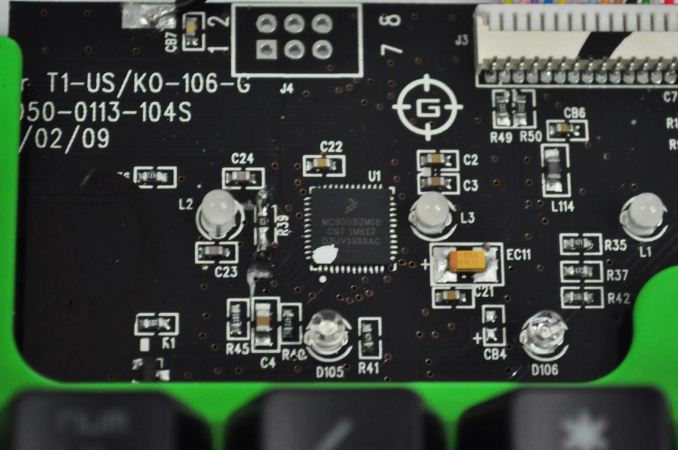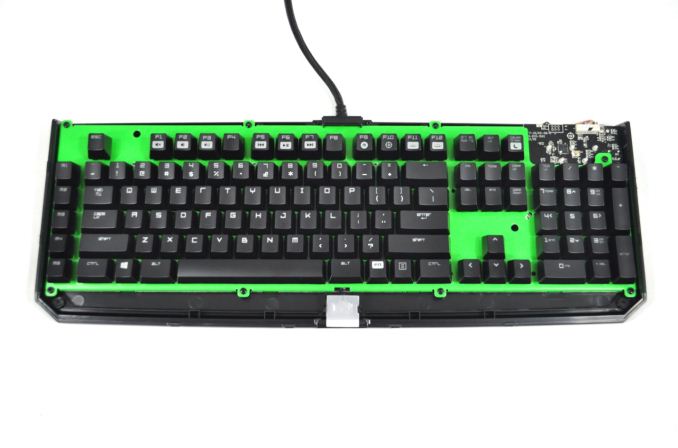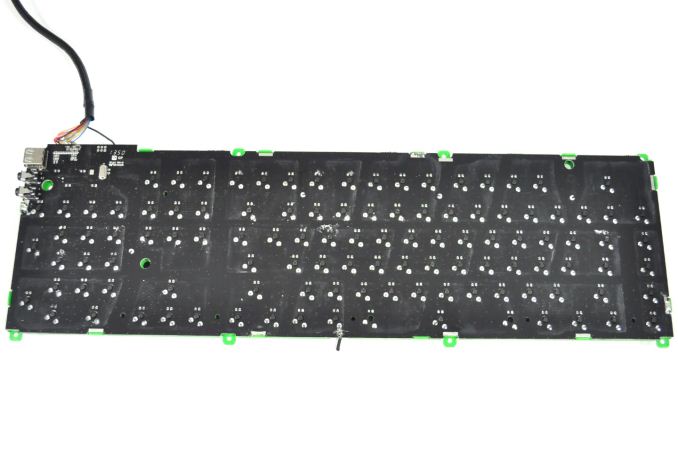Razer BlackWidow Ultimate Mechanical Gaming Keyboard Review
by E. Fylladitakis on April 2, 2014 8:05 PM EST- Posted in
- Keyboard
- Razer
- mechanical
A closer look
Visually, the new version of the BlackWidow Ultimate is essentially identical to the 2013 version. Thankfully, Razer ditched the glossy plastic frame after the 2012 version and is now using a soft, matte black frame, which is not as prone to fingertips as the first versions of the keyboard. Other than that, the keyboard follows a typical full keyboard layout (US layout for our sample), with the exception of five extra macro keys on the far left side of the board. Most of the keys are very firm and robust, with the exception of the larger keys. Razer is using stabilizer bars beneath the larger keys, which do give a uniform feeling while pressing them but they hardly do anything to stop the keys from wobbling.
Two headphone jacks and a USB port can be found on the right side of the keyboard. The bottom of the keyboard is rather plain, with only five small rubber anti-skid pads and two height adjustment feet. A thick braided cable leaves the top side of the keyboard, ending in two USB connectors and two 3.5mm headphone connectors. One of the USB connectors is required for the BlackWidow Ultimate itself; the second connector is necessary only for the USB port on the left side of the keyboard to function.
Once powered, the first thing that you will notice about the BlackWidow Ultimate is the backlighting. By that, we do not mean the unique bright green color but rather how powerful the backlighting is. At the maximum setting, the backlighting is annoyingly bright even inside a well-lit room. Thankfully, there are about 18 brightness settings ranging from off to maximum, allowing the user to find a comfortable setting. Razer's logo is also lit up. Only the primary character of each key receives backlighting; the secondary functions are simply printed on the keycaps. The only key that has no backlighting at all is the FN key.
Additional functions are available by holding down the FN key and pressing one of the function keys. The F1-F3 keys are used for volume control, the F5-F7 keys for multimedia functions. The F9 key will initiate on-the-fly macro recording and the F10 key will put the keyboard into its "gaming mode", which essentially disables some of the keyboard's functions like the Windows key. By holding down the FN key and then pressing the Pause button, you can put your computer into sleep. Finally, the F11 and F12 keys can be used to control the backlighting.
There is little of interest below the cover of the BlackWidow Ultimate. Removing it reveals the green stabilization board that the keys are secured on. The bright green board actually plays a very important role in the overall appearance of the keyboard, creating a uniform visual effect between the backlit keys. The Freescale MC9S08JM16 controller can be seen on the top left side of the board. Razer however needs to improve their soldering job. As can be seen from the pictures in the gallery, there are many uneven soldering points and it appears that the assembly has been rushed.
The major (and, apparently, only) difference between the 2013 and the 2014 versions is the use of the new Razer Green/Orange switches instead of the Cherry MX Blue/Brown switches of the old version. As this is the sole differentiator, let's spend some time discussing how they feel and function.




















64 Comments
View All Comments
Thefinaleofseem - Thursday, April 3, 2014 - link
Does Synapse still require you to register an account online just to adjust the settings for the keyboard? That was the case not too long ago. I'm not touching another Razer product until that goes away entirely.Dustin Sklavos - Thursday, April 3, 2014 - link
Unfortunately, yes. I'm not aware of this having changed.crazysurfanz - Thursday, April 3, 2014 - link
Yeah, I was wondering about this and was surprised it wasn't mentioned in the review at all. Unfortunately that's a deal breaker for me, I won't be buying a keyboard that needs me to register an account with anything.Morawka - Thursday, April 3, 2014 - link
you guys can cry about it all you want, but the cloud is the way to go. There's always going to be a few that cry about a feature that benefits the 90th percentile. Your in luck tho, you can still find a few keyboards that include DRAM on board to save your settings, but its archaic.Razer listened to the minority and added the offline mode feature, something you should be grateful for (a companies willingness to listen to the minority). But to some its still not good enough. At the very least sign up so you can register your product. Razer is heading towards being a mobile devices company (pc's, laptops, tablets, wear-ables etc..), and the cloud is ever important in that area.
Thefinaleofseem - Friday, April 4, 2014 - link
The Cloud is fine as an OPTION, not a requirement, especially on a product where cloud integration is largely useless fluff. Who the hell needs their mouse and keyboard settings in the cloud when it's perfectly possible to save them locally? How many people would ever make use of it?doggghouse - Thursday, April 3, 2014 - link
You probably still have to create an account, but as soon as you finish the initial setup, you can switch the software into "Offline" mode, and it will stay that way. The only reason to switch back to "Online" is if you wanted to store your settings in the cloud. Also, it won't do automatic updates unless you're signed in.Thefinaleofseem - Thursday, April 3, 2014 - link
It's still BS to force registration before you can configure a local device.Stuka87 - Thursday, April 3, 2014 - link
Yes, but to me this is a feature that I like. Your profiles are all in the cloud. So if you have multiple desktops, or go to somebody else's house that has razer gear, you just login and BAM, all your settings are there. Its very cool.Thefinaleofseem - Friday, April 4, 2014 - link
Handy if you want it, sure, but being required to use it? No thanks.meacupla - Thursday, April 3, 2014 - link
Why does Razer insist on having no cable management under the keyboard and having the cable come out from the middle?And to top it off, it's not even removable?